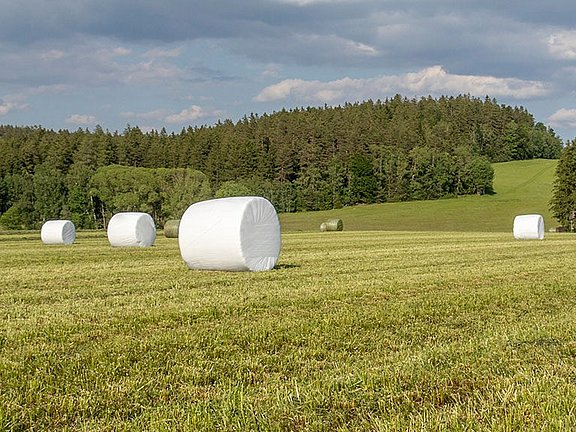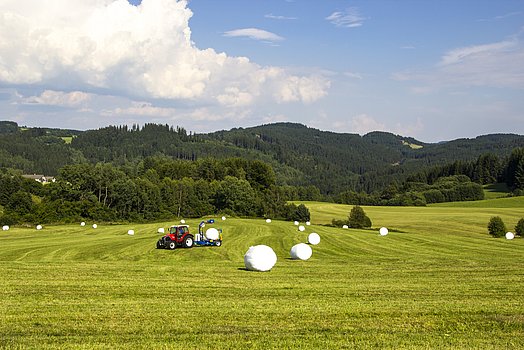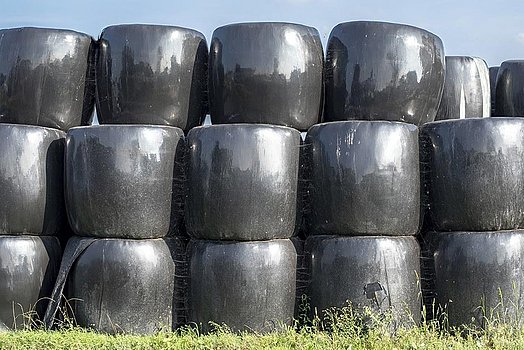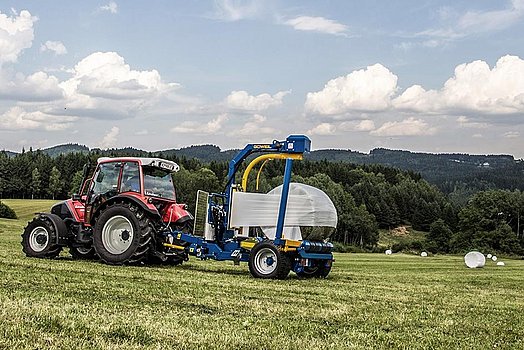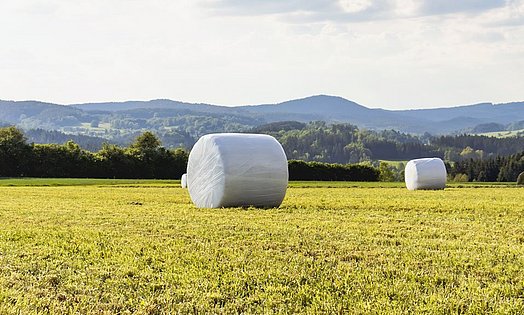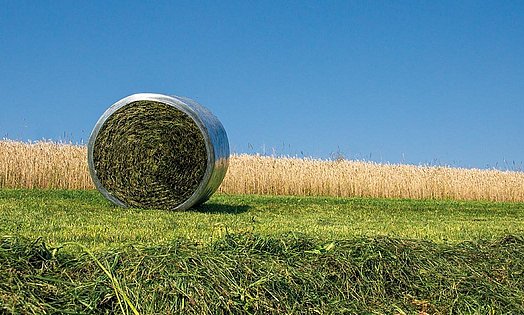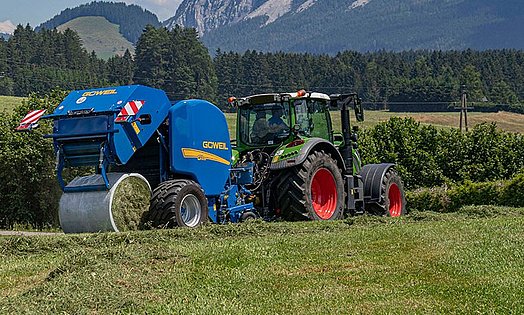FAQs Agricultural Stretch Film
Frequently asked questions on the topic of wrapping film & wide film
What are agricultural stretch films and what are they used for?
So-called wrapping films and net replacement films are stretchy, tear-resistant and extra thin films that are used for feed preservation purposes. After being pressed into bales, the crop is sealed airtight by being wrapped in film with an overlap. This creates the conditions necessary for a successful ensiling process. Strictly requiring low oxygen levels, this process converts carbohydrates into preserving lactic acid.
What is agricultural stretch film made of?
The film most commonly chosen for bale silage is made of polyethylene, the most widely used plastic in the world. The starting product for this material is ethylene - a gas synthesized from crude oil and natural gas. Polyethylene is available in a variety of types with different densities and resulting material properties. Is it used for a multitude of packaging products. What is more, bags, films, containers for beverages, cleaning agents or cosmetics as well as interior linings and cable sheathing are predominantly made of polyethylene.
Film width, film thickness and linear length of the wrapping film
The width that is common for rolls of wrapping film and used as standard in all GÖWEIL wrapping machines is 750 mm for round bales and for square bales. Older wrappers made by other manufacturers are also operated with stretch films that are 500 mm wide.
The film thickness is given in µ, or micrometers, with one µ equaling 0.001 mm. Wrapping films are primarily offered in thicknesses ranging between 19 and 25µ.
A film measuring 25µ is suitable for universal use. Films with a reduced thickness of 19 - 22µ and high quality usually offer the same properties in terms of stretchability, resistance to perforation and oxygen permeability. Owing to the lower thickness of the film, these film rolls mostly have a longer linear length, resulting in extended use that translates to fewer roll changes and savings in time compared to the standard thickness.
Commercially available are stretch films with linear lengths ranging between 1,500 and 2,200 m. The weight of the film rolls gives an indication as to their quality.
Tip: We suggest that you let your decision between the large number of film manufacturers be guided by a test of different rolls that have the same thickness, linear length and width.
Which color should agricultural stretch film have?
The most widely used films come in shades of green, in black or in white. Some manufacturers also offer transparent films, which make it possible to spot directly not only which crop is contained in the bale but also if the contents of the bale has suffered any noxious fermentation caused by damage or inadequate ensiling.
Today, wrapping films are also available in such additional colors as blue, yellow, pink or purple. Brighter colors offer certain advantages in warmer regions as bales wrapped in a bright wrapping film will not heat up as much in the more intense solar radiation than bales wrapped in darker stretch film, lowering the risk of losing nutrients.
Wrapping film in action - what do I need to consider?
The adhesive responsible for the adhesion between the individual layers of film is “activated” by elongating (stretching) the film. Stretch film is usually stretched by 60-70%. Stretching the film beyond this limit is not recommended on account of the waist formation, which will result in reduced overlap caused by more narrow film webs. Regular cleaning of the stretching rollers will promote a smooth work flow.
It goes without saying that you should use undamaged rolls of film only. It is best to wait to remove any packaging from the agricultural stretch film until immediately prior to use.
Also, pay attention to the correct setting of the knives and make sure they provide for a clean cut of the film webs.
When operating in high outside temperatures, you may experience frequent film tears as the stretchability and tear resistance of the films vary with the temperature. What is more, working in rainy weather may also have a negative impact on the adhesion between the individual layers of film.
[Translate to English:]
[Translate to English:]
Breite: Agarstretchfolie mit 750 mm als Standardmaß
Die heute übliche Breite für Wickelfolienrollen und Standard in allen GÖWEIL Wickelgeräten für Rundballen und Quaderballen beträgt 750 mm (75 cm). Ältere Wickelgeräte anderer Hersteller werden auch mit 500 mm (50 cm) breiten Stretchfolien betrieben. Kleinere Folienbreiten mit 250 mm, 360 mm oder 375 mm werden lediglich für sogenannte Mini-Rundballen verwendet.
Länge: Lauflänge von 1500 m und mehr
Für Landwirte spielt die Lauflänge der Folie in der Regel keine große Rolle. Die 750 mm breite Agrarstretchfolie wird üblicherweise mit einer Länge von 1500 m angeboten. Es gibt aber durchaus auch etwas höhereLauflängen mit 1650 m oder 2000 m. Im Handel sind Stretchfolien mit Lauflängen zwischen 1500 m und 2200 m erhältlich. Die 500 mm breite Wickelfolie ist meist mit einer Lauflänge von 1800 m erhältlich.
Stärke: Dünnere Folien mit gleichwertigen Eigenschaften
Die Folienstärke wird in µ oder Mikrometer angegeben, ein µ entspricht 0,001 mm. Wickelfolien werden meist in Stärken zwischen 19 und 25 µ angeboten.
Eine Stretchfolie mit 25 µ kann universell eingesetzt werden. Stärkereduzierte Folien mit 19 – 22 µ von hoher Qualität haben in der Regel gleichwertige Eigenschaften was Dehnbarkeit, Durchstoßfestigkeit und Sauerstoffdurchlässigkeit angeht. Durch die geringere Dicke der Stretchfolie haben diese Folienrollen meist eine höhere Lauflänge, bei deren Verwendung sich durch weniger Rollenwechsel eine Zeitersparnis gegenüber den Standardstärken ergeben kann.
Gewicht: Qualität erkennen
Das Gewicht der Folienrollen gibt Aufschluss über deren Qualität. Die Rollen sollten in der Regel folgendes Gewicht aufweisen:
| Breite | Länge | Gewicht |
| 500 mm | 1800 mm | ca. 22,20 kg |
| 750 mm | 1500 mm | ca. 28,00 kg |
Eine Differenz von bis zu 5 % ist aber durchaus möglich.
Tipp: Testen Sie als Hilfestellung zur Entscheidung zwischen den zahlreichen Folienherstellern doch einmal Rollen gleicher Stärke, Lauflänge und Breite gegeneinander.
How many layers of film should I use?
When it comes to the number of film layers, nearly all film manufacturers recommend 6 wrapping rotations. Since polyethylene is not 100% gastight, proper feed preservation necessitates a multifold overlap to ensure flawless feed quality. Depending on their dry matter concentration and structure, certain forage grasses such as alfalfa, clover and ryegrass may best be wrapped 8 - 10 times. The greater number of layers keeps the wrapping film from being penetrated by the coarser or more solid parts of the plants, increasing the probability of the successful preservation of the precious base feed.
What next? How do I dispose of and recycle silage film after use?
We will provide you with an overview of proper disposal and recycling as well as biodegradable alternatives to agricultural stretch film in another installment of our series on film. Read now:
Recycling agricultural stretch films
What is there to know about wide film?
Wide film is a net replacement film, meaning that it is used in lieu of round bale nets. The G-1 F125 Kombi and the LT-Master come standard with one film binding unit. Available as an option is a dual binding unit, which allows customers to choose between net and wide film or insert two rolls of wide film and thereby cut the binding time in half. If selected with the adequate width, the wide film (the available roll widths range from 1,250 to 1,400mm) will contour around the edges of the bale and enclose them to provide additional protection against mechanical damage. It also ensures the stable shape of the bales, keeping them from expanding to a lesser extent during baling. You can purchase net replacement films in thicknesses and linear lengths of, respectively, 16 - 20 µ and approximately 1,800 - 2,200m. Better yet, you will have to deal with only one type of waste consisting of wrapping film and wide film, allowing for easier disposal and recycling.
If you have any other questions on the use of an agricultural stretch film in GÖWEIL balers and wrappers, our sales team will be happy to assist you.
STORING STRETCH FILM PROPERLY
The first part of our series on everything there is to know on agricultural stretch film will also teach you how to ensure a smooth work flow by storing the film rolls properly.
[Translate to English:]
Tipps für den Einsatz – Was sollte man bei der Verwendung von Agrarstretchfolie beachten?
[Translate to English:]
- Der für die Haftung der einzelnen Folienlagen verantwortliche Kleber wird durch eine Vorstreckung (Stretchen) der Folie „aktiviert“. Üblich ist eine Vorstreckung der Stretchfolie von 60-70 %. Stärkeres Dehnen ist wegen der Taillenbildung und der damit verbundenen geringeren Überlappung durch schmalere Folienbahnen nicht zu empfehlen.
- Eine regelmäßige Reinigung der Vorstreckwalzenbegünstigt einen reibungslosen Arbeitsablauf.
- Selbstverständlich sollten Sie nur unbeschädigte Folienrollen verwenden.
- Etwaige Verpackungen der Agrarstretchfolie entfernen Sie am besten erst direkt vor der Verwendung.
- Achten Sie außerdem auf die genaue Einstellung der Messer und einen sauberen Abschnitt der Folienbahnen.
- Bei hohen Außentemperaturen kann es vermehrt zu Folienabrissen kommen, da Dehnbarkeit und Reißfestigkeit der Folien temperaturabhängig sind. Eine Verarbeitung im Regen kann die Haftung der einzelnen Folienlagen ebenfalls negativ beeinflussen.
Wie viele Lagen Folie sollen zum Wickeln verwendet werden?
Bezüglich der Anzahl der Folienlagen wird eine 6-fache Wicklung als Standard von nahezu allen Folienherstellern empfohlen. Da Polyethylen nicht 100 % gasdicht ist, ist für eine gute Futterkonservierung eine mehrfache Überlappung zur Sicherstellung der Futterqualität unabdingbar. Ackerfutter wie Luzerne, Klee oder Weidelgras sollte je nach Trockenmasse und Struktur besser 8-10-fach gewickelt werden. Die höhere Anzahl Lagen der Wickelfolie verhindert ein Durchstoßen der gröberen und festeren Pflanzenteile und bietet höhere Sicherheit für die Konservierung des wertvollen Grundfutters.
Stretchfolien richtig lagern
Um die Langlebigkeit und Effektivität von Stretchfolien zu gewährleisten, ist eine sachgemäße Lagerung unerlässlich. Stretchfolien sollten an einem kühlen, trockenen und vor direkter Sonneneinstrahlung geschützten Ort aufbewahrt werden. Extreme Temperaturen und hohe Luftfeuchtigkeit können die Materialeigenschaften der Folie beeinträchtigen und zu vorzeitigem Verschleiß führen. Eine horizontale Lagerung auf sauberen, ebenen Flächen verhindert Verformungen und Beschädigungen der Rollen. Zudem sollte die Folie vor mechanischen Belastungen und scharfen Gegenständen geschützt werden, um Risse und andere Schäden zu vermeiden. Durch die Beachtung dieser Lagerungshinweise bleibt die Agarstretchfolie lange in einem optimalen Zustand und erfüllt ihre Funktion zuverlässig.
Alle Informationen zur richtigen Lagerung von Agrarstretchfolie!
Entsorgung und Recycling der Silofolie
Einen Überblick über die Möglichkeiten zur Entsorgung, Recycling und biologisch abbaubare Alternativen von Agrarstretchfolien können Sie hier nachlesen:
